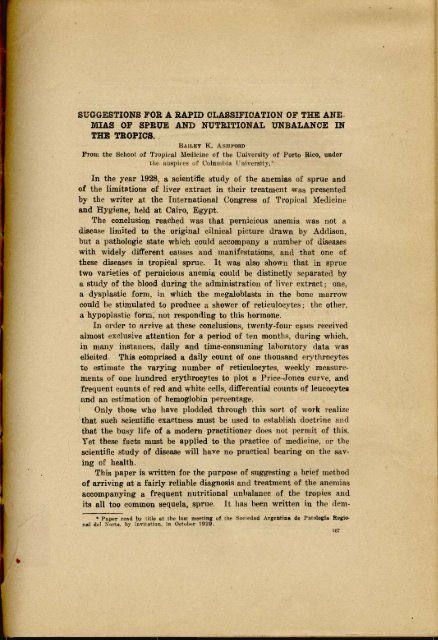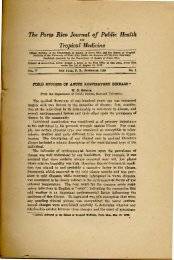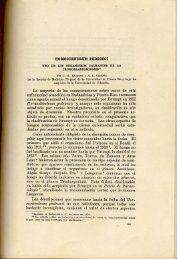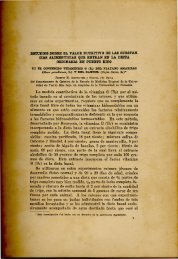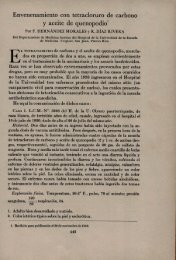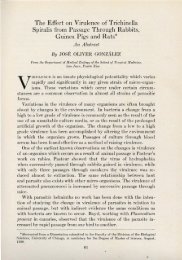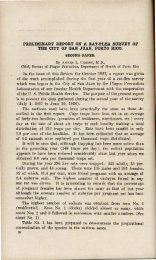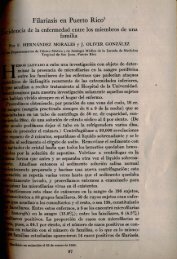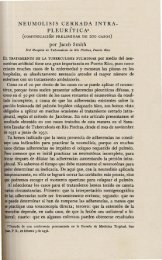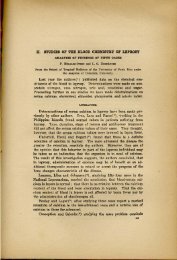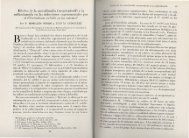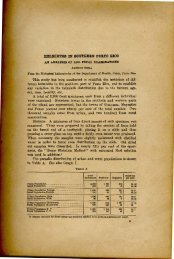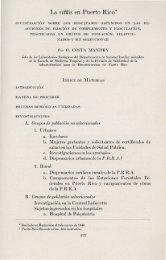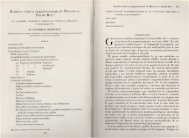Classification of Anemias.pdf
Classification of Anemias.pdf
Classification of Anemias.pdf
You also want an ePaper? Increase the reach of your titles
YUMPU automatically turns print PDFs into web optimized ePapers that Google loves.
SUGGESTIONS FOR A RAPID CLASSIFICATION OF THE ANE<br />
l\oIIAS OF SPRUE AND NUTRITIONAL UNBALANCE IN<br />
THE TROPICS..<br />
H ,\ILl:Y K. A S IU'OJ(D<br />
From the Schoo l <strong>of</strong> 'I'ropicul Medil·ine <strong>of</strong> th e Uuivursity <strong>of</strong> Port-o Rico, under<br />
th e auspices <strong>of</strong> Columbia l: niversity. "<br />
In the year 1928, a scientific study <strong>of</strong> the anemias <strong>of</strong> sprue and<br />
<strong>of</strong> the limitations <strong>of</strong> liver extract in their treatment was presented<br />
b)' the writer at the Internati onal Congress <strong>of</strong> Tropica l Medicine<br />
and Hygiene, held at Cai ro, Egypt.<br />
The conclusion reached was that pernicious anem ia was not It<br />
disease limited to the original cilnieal picture drawn by Addison,<br />
but a pat hologic state wh ich could accompany a number <strong>of</strong> diseases<br />
with widely different cau ses and man ifestations, and t hat one <strong>of</strong><br />
these diseases is tropical sprue. It was also show n that in sprue<br />
two varieties <strong>of</strong> pernicious anemia could be distinctly separated by<br />
a study <strong>of</strong> the blood during the administration <strong>of</strong> liver ext ract ; one.<br />
a dysplastic form, in which the megaloblasts in the bone marrow<br />
could be stimulated to produce a shower <strong>of</strong> reti euloeytes , the oth er,<br />
a hypoplast ic form, not responding to this hormone.<br />
I n order to arrive at these conclusions, twenty-fou r eases received<br />
almost exclusive attention for a period <strong>of</strong> ten months, during which,<br />
in many ins tances, daily and time-consuming lab oratory data was<br />
elicited. This comprised a daily count <strong>of</strong> one thousand erythrocytes<br />
to estimate the varying number <strong>of</strong> retieuloeytes, weekly measurements<br />
<strong>of</strong> one hundred erythrocytes to plot a Price-Jones curve, and<br />
,fr equent counts <strong>of</strong> red and white cells, differential counts <strong>of</strong> leucoeytes<br />
and an esti mation <strong>of</strong> hemogl obin percentage.<br />
I Only those who have plodded through this sor t <strong>of</strong> work l'calize<br />
that such scientific exactness must be used to establish doctrin e find<br />
that the busy life <strong>of</strong> a modern pr-actitioner does not permit <strong>of</strong> this.<br />
Yet these facts must be applied to the practice <strong>of</strong> medicine, 01' t he<br />
scientific study <strong>of</strong> disease will have no practical bearing on th e saving<br />
<strong>of</strong> health.<br />
This paper is written for the purpose <strong>of</strong> suggesting a brief method<br />
<strong>of</strong> arriving at a fairly reliable diagnosis and treatment <strong>of</strong> the an emias<br />
accompanying a frequent nutritional unbalance <strong>of</strong> th e tropics and<br />
its aU too common sequela, sprue. 1t. has been written in the dem<br />
• P aper r ead by litl . al the lnal meetinjt <strong>of</strong> lh e<br />
nal dr-l ~ ort •. by in vit nt io n. in Octub{-T 1929 .<br />
oc iedn d Ar jteDtiDa de Pntolor f.. Rejtlo·<br />
107
168 PORTO RICO JOURNAL OF PUBI,IC HEALTH A..~D TROP. MEDICINE<br />
oeratie spirit which should inspire one who attempts to suggest to<br />
his colleagues a plan <strong>of</strong> action which must be feas ible, and which<br />
should at the same time satisfy their scientific scr uples. That is<br />
to say, it opens the door to all over-wor ked physicians to say how<br />
much or how little clinical laboratory work must needs be performed<br />
before it is possible to arrive at ;.a fairly reliable diagnosis and<br />
treatment" <strong>of</strong> these anemias.<br />
The method employed by the writer, with exceptions imposed by<br />
an unusual pressure <strong>of</strong> work, has been as follows:<br />
( - 1. All persons suffering from clinical sprue or its preceding nutritional<br />
unbalance have their hemoglobin percentage estimated by the<br />
Dare instrument (two minutes).<br />
2. All cases with a hemoglobin <strong>of</strong> less than seventy per cent receive<br />
a red cell and <strong>of</strong>ten a white cell count (ten to twelve minutes).<br />
3. All cases coming under thc latter category with a color index<br />
<strong>of</strong> plus 1. or over and with a hemoglobin below fifty per cent, r eceive<br />
in addition a differential count <strong>of</strong> Jeucoeytes and a careful measurement<br />
<strong>of</strong> ten erythrocytes in a field enabling one to take these ten<br />
cells as they come, one after the other in the same traverse, without<br />
selecting cells that are interestingly large or small (a dangerous<br />
pitfall for an honest average). 'I'hese measurements should be made<br />
with the best filar eye-piece micrometer obtainable ; that is to say, one<br />
which will distinguish one-tenth <strong>of</strong> a micron. In addition, this must<br />
always be supplemented by a count <strong>of</strong> reticulocytes. Both procedures<br />
can be accomplished on the same slide by Jetting a drop <strong>of</strong> a 0.3%<br />
solution <strong>of</strong> cresyl blue in absolute alcohol, fall on the end <strong>of</strong> II glass<br />
slide and when it dries, working the drop <strong>of</strong> blood, caught on the edge<br />
<strong>of</strong> the end <strong>of</strong> another slide, back and forth until it incorporates the<br />
stain before making the smea~. It is now stained by Wright's or<br />
Leishman's method and is ready for cell measurement, reticulocyte<br />
count, and (although the cresyl blue changes some differential characteristics<br />
<strong>of</strong> the leucocyte) a differential count. This should not reo<br />
quire over twenty minutes, and less, if the following technique is<br />
followed:<br />
Let into the eye-piece <strong>of</strong> th e microscope a glass disk enclosing<br />
about 250 cells in a well spread smear. If the cells are unusually<br />
large or small, one circle-full can be counted as a standard fOI" the<br />
other three. The reticulocytes are now counted in four <strong>of</strong> such<br />
circles considering each circle to contain 250 cells, or more or less<br />
circles if a standard count demands it_ One is sure to make a ten<br />
per cent, and possibly a twenty-five per cent error, but this will<br />
not prevent the possibility <strong>of</strong> deducing that there has, or there has
SUGGESTIONS FOR .... RAPID CLASSIFICATION OF T IlE ANEML\.S, ETC. 169<br />
not been a real efficient reticulocytosis in response to liver extract.<br />
This, after all, is the information desired.<br />
4. All cases presenting a pernicious type <strong>of</strong> anemia should have<br />
reticulocyte counts made four, seven, and ten days after the first<br />
administration <strong>of</strong> liver extract in order to catch, at least, the up<br />
or down curve <strong>of</strong> the reticulocyte peak. Such eases can be safely<br />
diagnosed dysplastic anemia, and the maintenance dose <strong>of</strong> liver extract<br />
should be insisted upon.<br />
Those cases which do not respond to liver extract after two weeks<br />
<strong>of</strong> administration may' at least be suspected <strong>of</strong> being hypoplastic and<br />
the continuance <strong>of</strong> this expensive remedy would seem to be an unnecessary<br />
drain upon the patient's pocket-book.<br />
There are many reasons why this examination should be conducted<br />
in the presence <strong>of</strong> the patient, not the least <strong>of</strong> which are his<br />
vizualization <strong>of</strong> the scientific methods employed to arrive at a correct<br />
diagnosis, and the decision which can be reached while the clinical<br />
supposition is fresh in the physician's mind. If this work can be<br />
confided to a well-trained laboratory assistant while the clinical examination<br />
is going on, the result will be still more satisfactory.<br />
There are many little flourishes that may be employed to make the<br />
diagnosis and course <strong>of</strong> the disease more vivid. For example, it is extremely<br />
nice, and, at the same time, useful, not to be satisfied with one<br />
Price-Jones curve, but make not less than one Price-Jones curve a week.<br />
The reduction in anisocytosis is thus more sharply defined and the<br />
return to a normal mean and a more closely approximated median<br />
gives a more convincing pro<strong>of</strong> <strong>of</strong> approaching recovery. Of course,<br />
under such circumstances it would be necessary to measure one hundred<br />
cells each time. A very satisfying evidence <strong>of</strong> improvement<br />
may be brought out by weekly differential counts in' a substantial<br />
eosinophilia and a reduction in relative lymphocytosis. .A pains-taking<br />
count <strong>of</strong> platelets reveals that their increase is an emergence from<br />
the shadow <strong>of</strong> a pernicious anemia.<br />
But all these latter procedures, and perhaps many more can by<br />
no means be <strong>of</strong> sufficient importance to warrant the neglect <strong>of</strong> waiting<br />
patients and the expenditure <strong>of</strong> the valuable time <strong>of</strong> an overworked<br />
and underpaid practical doctor <strong>of</strong> medicine. All <strong>of</strong> these<br />
things can, and should be done in a hospital, but in the eager search<br />
for the essentials in an out-patient clinic or in the private consulting<br />
room, the time they require is generally prohibitory.<br />
No one knows better than the writer that the suggested plan for<br />
the rapid determination <strong>of</strong> the anemias <strong>of</strong> the tropics must at, times
170 PORTO RICO JOURNAL OF PUBLIC HEALTH AND TROP. ){EDICINE<br />
bring errors, that it cannot be perfect, but is it not better than the<br />
method used by the average practitioner today Y Does it not, after<br />
all, hold its place satisfactorily among all <strong>of</strong> the usual methods and<br />
processes <strong>of</strong> thought upon which most <strong>of</strong> us depend for a "clinical<br />
diagnosis" 7 Our clinical sense, aided by a hint from the laboratory<br />
will generally bring us to a more elaborate examination <strong>of</strong> blood in the<br />
given case.<br />
Probably most <strong>of</strong> us will agree that to withhold liver or an extract<br />
there<strong>of</strong> in the presence <strong>of</strong> a true pernicious anemia, and load iron<br />
into a liver already choked with it is reprehensible. Yet, few realize<br />
the frequent hypoplastic forms <strong>of</strong> pernicious anemia in the<br />
tropics to be a true exhaustion process, in which a continuance <strong>of</strong><br />
liver extract will only serve to drain the purse <strong>of</strong> the poor who need<br />
the money to restore the blood-making organs by proper food. If<br />
after intelligent diet these organs can have their vital elements built<br />
in again by nature, a second trial with liver extract may succeed,<br />
especially if we take into account that back <strong>of</strong> all, there is an already<br />
impotent liver which needs protection against dietary abuse, and<br />
nourishing food for its own tissues. In a long series <strong>of</strong> chemical<br />
analyses <strong>of</strong> the blood in cases <strong>of</strong> sprue and its anemia <strong>of</strong> pernicious<br />
type, there is to be seen quite regularly, a very low cholesterol content<br />
and a high icteric index. But time forbids the tabulation <strong>of</strong><br />
this data in this paper.<br />
If what may be a pardonable error in insisting upon liver in<br />
hypoplastic anemia can be condoned, what shall we say <strong>of</strong> the practice<br />
<strong>of</strong> administering liver extract by routine in secondary anemia<br />
and worst <strong>of</strong> all, in hemoglobinemia Y Such conditions usually mean<br />
a dissolution <strong>of</strong> hemoglobin and erythrocytes in circulation, not a<br />
a failure <strong>of</strong> the hemopoietic organs.<br />
The writer believes that he has never seen a more precise and<br />
more narrowly limited therapeutic agent than liver extract, judging<br />
from the evidence so far produced. Liver extract will practically always<br />
bring about a shower <strong>of</strong> reticuloeytes and at least an apparent<br />
cure in von Biermer's dysplastic pernicious anemia. In the experience<br />
<strong>of</strong> most <strong>of</strong> us, however, it will not bring about this shower<br />
in secondary anemia. It may do so in a blood, temporarily possessing<br />
a low color index, but in one which measurement <strong>of</strong> erythrocytes<br />
and a wide dispersion i(anisocytosis) show to be essentially a megoblastic<br />
affair. It may have the same effect in a pernicious anemia<br />
blood with a temporary low color index and a microcytosis, but the
SUGGESTIONS FOR A RAPID CLA~SIFICATION OF THE AN E)!lAS, ETC. 171<br />
Price-Jones curve, properly made will easily disclose the nature <strong>of</strong><br />
such " secondary" anemias, A t rue aplasia <strong>of</strong> the bone marrow was<br />
found at autopsy in One <strong>of</strong> my cases <strong>of</strong> pernicious anemia due to<br />
sprue and not responding to l!ver extract by Pr<strong>of</strong>essor R. A. Lambert<br />
<strong>of</strong> this School two years ago, and section <strong>of</strong> bone marrow by biopsy<br />
in a series <strong>of</strong> such eases now being made by others will demonstrate,<br />
I believe, that aplasia and hypoplasia is the rule in these clinical<br />
types.<br />
It i hoped that liver extract may be an efficient reducer <strong>of</strong><br />
high blood pressure but that thi s is a scientific fact is not yet sufficiently<br />
demonst rated to bring about a doctrinal acceptance. It is<br />
not denied that the present belief in a potent hormone on the part<br />
<strong>of</strong> th e lay pu blic, who attrib ute to it a dominant power to overcome<br />
all anemias, as well as many strange influences on other organs and<br />
their f unctions, may not some day prove to be in some indirect<br />
measure justified, but the practicable, un questiona ble fact confronting<br />
us now is that no sufficient evidence has been produced to show<br />
that such effects are due to liver. F acts in Medicine are not commonly<br />
proven alone hy one man ' 8 flzures but by those <strong>of</strong> many<br />
r eputable investigators.<br />
Working on th e clinical plan set forth, the 209 cases in which the<br />
condition <strong>of</strong> blood in sprue an d digestive incompetence was investigated<br />
yield thc following r esults :<br />
CASES L'(<br />
wmcn ON LY THE HEMOGLOB IN WAS INVESTIGATED<br />
Normal H emoglobin (90-100 plus per cent).<br />
Total nutnber <strong>of</strong> cascs ' 14<br />
Avera ge Hemoglobin perccntage 98.3<br />
Cases <strong>of</strong> sp rue (3 severe, 4 moderate)_ ______________________________ 7<br />
Average hemoglobin perc entage 102.3<br />
Digest ive incompet ence (t he syndrome <strong>of</strong> th e prevalent nut ritional unbalan<br />
ce <strong>of</strong> t his Islan d) 7<br />
Aver ag e hemoglobin 94. 4<br />
Calle. wit h a hcmoglob in perc cntage<br />
Total nu mber <strong>of</strong> such cascs<br />
Aver ag o hemoglobin perc ent age<br />
Cases <strong>of</strong> spruc<br />
belOID 90.<br />
74.8<br />
Average hemoglobi n 74. 8<br />
Digestive incompet cnee.,, __ __ ___ ____ __ 50<br />
Average hemoglobin ~ H .8<br />
Loss <strong>of</strong> weight in the above cases:<br />
Average <strong>of</strong> 29 cases <strong>of</strong> spru e<br />
26. 5 pounda<br />
Aver age <strong>of</strong> 38 cases <strong>of</strong> digcstive incompetence 17.5 "<br />
84<br />
34
172 PORTO RICO JOUR1'UL OF PUBLIC HEALTH AND TROP. :a.lEDICI\E<br />
CA8l:& IN WHICH BEllOGLOBIN PERCENTAGE WAS TAKEN AND ImVTHItOCYTltB<br />
COUN TED<br />
Hemoglobinemia and Secondary Anemia (non-megalobla.1tio anemia)<br />
Total nuxnber <strong>of</strong> such cases 9<br />
Casel <strong>of</strong> spruc 34<br />
Average hemoglobin percentage 63.4<br />
Cases with 5,000,000 cells per cmm. or over 15<br />
Cases with 6,000,000 cells per cmm, or over___ _________________ ______ ~<br />
Cales with 7,000,000 cells per cmm. or over 11<br />
Average erythrocyte count per cmm, 4,876,470<br />
Cases <strong>of</strong> Digestive incompetence 85<br />
A'I"erage hemoglobin percentage 61.1<br />
Cues with 5,000,000 cells per cmm. or over 17<br />
Cases with 6,000,000 cells per cmm. or over .:_____ 8<br />
Cases with 7,000,000 cells per cmm . or o\'e£- _________________________ 5<br />
Average erythrocyte count per cmm. 5,314,485<br />
(One ease had 8,440,000 and another 10,232,00D-the latter a child<br />
<strong>of</strong> two years.)<br />
LOiS <strong>of</strong> weight in above casea :<br />
Average <strong>of</strong> 24 cases <strong>of</strong> sprue<br />
28. 1 pounds<br />
Average <strong>of</strong> 23 eas es <strong>of</strong> digestive incoxnpetence___ 17 pounds<br />
Average hemoglobin for all 69 cas es 65,7<br />
Average eryt hr ocyte count for all 69 cases 5,098,550 per cmm,<br />
Pernicious types <strong>of</strong> Anemia (Megaloblastic Anem ia.}<br />
Total num ber <strong>of</strong> such cases 42<br />
Cases <strong>of</strong> Sprue 38<br />
Average hemoglobin percentage 49. 6<br />
Cases with from 4,000,00D-5,000,000 cells per c=.__________ ______ __ °<br />
Caaea with 5,000, 000 or more cells p er cmm. 1<br />
Cases with 3,OOO,00D-4,000,000 cella p er emxn.________________________ 6<br />
Cases with 2,000,00D-3,000,000 " " ,, 16<br />
Casea with 1,000,00D-2,000,000 " " " 15<br />
Average erythrocyte count per emrn, 2,371,447.<br />
Cases <strong>of</strong> Digestive Incompetence____________________________________ ~<br />
Average hemoglobin percentage 47<br />
CMea with 8,000,000 to 4,000,000 or more cella per enun.____________ ___ 1<br />
Cases with 2,000,000 to 3,000,000 or more cella per emm. _______________ I<br />
Cases with 1,000,000 to 2,000,000 or mor e cella per emm. _____________ __ 1<br />
Cases <strong>of</strong> unknown etiology___________________ _______________________ 1<br />
Av erage hemoglobin perccntage 32<br />
Average erythrocyte coun t per cmm. 2,272,000<br />
Len <strong>of</strong> weig ht in above eases :<br />
Average <strong>of</strong> 38 cas as <strong>of</strong> sprue<br />
Average <strong>of</strong> 3 cases <strong>of</strong> digestive incomp cte nce<br />
37.1 pounds<br />
31.6 pounds<br />
In eleven <strong>of</strong> these forty-two cases the eolor index was less than 1,<br />
hut there were other reasons for considering them cases <strong>of</strong> pernicious
SUGGESTIONS FOR A RAPID CI,A8SIFlCATION OF THE ANEMIAS, ETC. 173<br />
anemia which, in the writer's mind, outweigh' this apparent discrepancy,<br />
notably, the greatly increased mean and median diameters.<br />
The average diameter <strong>of</strong> red cells, superior to 8 microns, in<br />
twenty-nine cases was 9.51 microns. The average diameter <strong>of</strong> red<br />
cells, inferior to 7.7 microns, in three cases was 6.22.<br />
Of the total forty-two cases, eighteen were demonstrated by their<br />
prompt response to liver extract to be dysplastic; eight by their<br />
failure to respond to this substance seemed to be hypoplastic. In<br />
the remaining sixteen cases either the time .element ,f or correct<br />
observation has been too short or they have failed to return for<br />
treatment and no classification is possible.<br />
Divided according to age periods, 206 <strong>of</strong> these cases are as follows:<br />
Syndrome<br />
Five·year age period s Nutritional<br />
Unbalance<br />
8pru~ Total<br />
--- ---<br />
1- • . . . •. •. • •. . . . . . . . I 3 4,<br />
ll-- 9. . ..... . . . .. .. . . .. .. . I I 2<br />
IG-I4 , . 1 3 (<br />
1ll--19 _ . 2 5 7<br />
20-24 . Jl 7 18<br />
25-211 . 12 11 23<br />
30-31 .. 10 12 22<br />
35-39. . •. . .•. •. . . . . ... .. . . . . . . •... . . .. 18 13 31<br />
4G-44 , . 7 14 21<br />
.5-
174 PORTO RICO JOURNAL OF P UBLIC H EAIJTH AND TROP. MEDICINE<br />
known error in technique, 'but in a badly dehydrated patient it is<br />
apt to completely ruin a correct estimation. This error is fre quently<br />
made by those whose tim e is limited. It is difficult to explain some<br />
<strong>of</strong> these abnormally high eryth r ocyte counts. My personal attention<br />
was given to the investigation as I had no intention <strong>of</strong> being deceived<br />
by poor technique, realizing as I did that a short cut means accuracy<br />
if reliable results arc to be expected. F irst <strong>of</strong> all, it is<br />
!believed that th e normal five million erythrocytes is too low in the<br />
tropics. The reasonabl e hypothesis in t he caSe <strong>of</strong> small doses <strong>of</strong><br />
poison, whether <strong>of</strong> mycotic, bacterial or <strong>of</strong> a chemical nature , (the<br />
latter the result <strong>of</strong> imperfect elimination <strong>of</strong> waste products) , is that<br />
these, like all poisons, stimulate before th ey depress. That in the<br />
early and mild anemias <strong>of</strong> sprue a toxic stimulus to the hemopoietic<br />
organs works in this manner , seems worthy <strong>of</strong> consideration.<br />
Another observation which can be made is that th e hemoglobin ,<br />
is, at least, only very indirectly affected by liver extract. This can<br />
be seen notably in case 15. H ere persistent use <strong>of</strong> liver extract<br />
seemed only to increase the erythrocytes, A more poignant question<br />
is: Wh at constitutes hematologically, a pernicious type '<strong>of</strong> anemi a '<br />
Certainly not color index alone (see cases 15, 38, 39, and others) .<br />
iNor cell diameters (see cases 24, 25, 26, 27) . The truth is that the<br />
best criterion is the Price-Jones curve. A high mean , a discordant<br />
medi an, and wide dispersion, after all, are the best hematologic evidenc<br />
e. The ti me-honored high color index is not to be despised,<br />
but a reference to case 25 alone, with its vigorous reticulocytosls<br />
after liver extract, will shake our hitherto blind faith in high color<br />
indices as a sine qua non <strong>of</strong>' pernicious anemia. The real diagnosis<br />
will be made from the sum total <strong>of</strong> accurate data, clinical and lab o<br />
r atory, after skillfully weighing all evidence , and this requires<br />
clinical and laboratory knowledge. Even with some facts considered<br />
t o be pathognomonic in the hematology <strong>of</strong> pernicious anemia:<br />
clinical experience is indispensable for interpretation.<br />
In looking over the ta bulatio n <strong>of</strong> cases <strong>of</strong> "secondary anemia" in<br />
this paper, it is inevitable that we should inquire : May not many<br />
<strong>of</strong> these be merely a. remission in the course <strong>of</strong> a pernicious typ e <strong>of</strong><br />
anemia The writer himself feels confident th at such is the ease,<br />
not for any considerable number, but certainly for some. The avarage<br />
cell diameter in the few in which such diam eters were taken<br />
bespeaks a secondary anemia, but there are elsewhere low values<br />
which may indeed be merely pernicious anemia. remissions.<br />
There are two very striking differences between the pernleious
SUGGESTIONS FOR A RAPID CLASSIFICATION OF THE ANEMIAS, ETC. 176<br />
anemia <strong>of</strong> Addison, seen in the temperate zone, and the pernicious<br />
anemia <strong>of</strong> sprue:<br />
(1) In only three <strong>of</strong> th e forty-two cases were normoblasts or<br />
megaloblasts seen, and then only extrem ely few. (2 ) The reticulocytosis<br />
following the administration <strong>of</strong> liver extract. is usually feeble<br />
(4 to 10 per cent ) compared to the vigorous rise <strong>of</strong> the curve -ap <br />
parently the rule in North ern countries, where, by the way, very<br />
few hypoplastic forms seem to exist.<br />
A final observation <strong>of</strong> much importance is the development <strong>of</strong><br />
pernieions types <strong>of</strong> anemia in the case <strong>of</strong> the seemingly strict nutritional<br />
unbalance <strong>of</strong> P orto Rico. The lamented Elders <strong>of</strong> Amsterdam<br />
insisted that pernicious anemia was the result <strong>of</strong> a nutritional<br />
unbalance. 'While, <strong>of</strong> course, it cannot be supposed that even the<br />
majority <strong>of</strong> cases have such a pathogenesis, without entering into<br />
any discussion it should be admitted that in three cases, undoubtedly<br />
bearing every evidence <strong>of</strong> being samples <strong>of</strong> the pure nutritional<br />
syndrome discussed in other papers, a true pernicious anemia developed.<br />
In closing, the writer has one statement to make concerning<br />
the diagnosis <strong>of</strong> sprue appear ing in these protocols. This diagnosis<br />
has only been mad e in a full ninety per cent <strong>of</strong> the cases on a clinical<br />
picture which I cannot conceive th at any well-informed physician<br />
could confuse with anything but the sprue <strong>of</strong> P atrick Manson, a raw<br />
tongue, a gaseous belly, a white frothy dia rrhea, a small liver, and<br />
a rapid emaciation. I have been so circumspect in this diagnosis<br />
that I have undoubtedly left among the cases diagnosed "digestive<br />
incompetence" many a case <strong>of</strong> incomplete or incipient sprue. But<br />
it is for those who read this paper to say whether th e suggestions <strong>of</strong>fered<br />
can be made help ful to our patients and to ourselves who, as a<br />
class, value above all things our reputation for accuracy and for<br />
judicious treatment.
l-'<br />
TABLE I.-CASES OF PERNICIOUS ANEMIA -:J<br />
C'l<br />
~<br />
. ~ o ... c Q<br />
.c .. '"<br />
~ o<br />
:0.." . '., ~ 'tl<br />
-e<br />
.~ ~ ~~ 0" SE =<br />
5"<br />
"c ".- Cause Variety .. ~ Erytbro- .9 - .. Days alter<br />
",E<br />
.. illg 2~ cytes !; ~~~<br />
. ~ t<br />
~"'::'<br />
gp.. '0 ~aa alp.. o<br />
'"<br />
~ ...: ",,- ::l '" '' D:l 0 -< ;::;<br />
"' .. IIver estrsct §<br />
- --- --- Q<br />
Ind igestion 12 years. Severe sprue one and a hair yevs. Eltremely III Bnd o<br />
I. . 64 20 .... Sprue Dyspl... 37 1,560,000 1.2 8.72 0 .1 ..............<br />
4.1 7 despondent. ColToo plnnter ruined by tbo cyclone. Now appu8Dtly well to,<br />
8 ................ 33 701,000 2.3 and energetic. AU symptolIl.9 have disappeared.<br />
g<br />
15 ................ 55 2,3 20,000 1.2<br />
:ll<br />
2.. Sll months severe sprue . Now no symptoms.<br />
56 45 .... Sprue Hypo.. . ss 2,9~, 000 I. 8 .75 O. ..·.. ..·····7· Z<br />
o.i ll<br />
t'<br />
7 ................ os 3,376,000 1.01<br />
21 ................ 67 3.664 ,000 0.92 o<br />
I>j<br />
S.. 67 .... .... Sprue . . . .. . . . . 38 2, 472, 000 0 .77 10.17 0.5 Normoblasts 'r ypical severe sprue.<br />
All th e symptoms 01sp rue ssve sore tongue. 00<br />
4.. «<br />
l\
11..1 g i g I ' Spru o DYS PI<br />
" 1 4 ~ 1 1' 620' 000 1 1.4 1<br />
0.6 , ..<br />
7 10.3 7<br />
21 77 3.200, 000 1.2 8.8<br />
30 80 3. 248, 000 I.2<br />
51 80 7,072,000 0.56<br />
1<br />
12..1 75 I 37 D .1. Dys pl. . . 35 1,690, 000 I 1. 03 2.7 .... ...... ... .<br />
7 . 5 .2 7<br />
12 40 . " ii:il8'<br />
13.. 1 &3 31 I... . Spru e Hypo. 57 2,5 00, 000 1.14 0 .6 ..............<br />
7 alt er Dy sp l., . 4.1 7<br />
8 43 3, 120, 000 0 .70<br />
22 43 1, 814, 000 I. 2<br />
39 .. .. 65 2, OSO, 000 1. 6<br />
45 50 1.872,000 1.3 5<br />
54 50 ............ ...... 9.77<br />
fl.I 50 I, 584, 000 I.6<br />
85 40 2,084 , 000 0.97<br />
92 70 2. 2M, 000<br />
99 •.. • .• ..... .• .• • 71 3, soo, 000 1.01<br />
100 47<br />
lIO 67 3. 240. 000 I. 03<br />
\4..1 &0 I 42 1 . ~ ~r.l ~ ~ .~ .~~~ ~ ' : : 1 21 60 r.ose.eoo 0 .74<br />
" 7 '1 ~ 1. 302, 000 1.6clnlly an lmprovement<br />
In her menta l cond iti on 8S she ls today enthu..iastlc and hope lui and ~<br />
willing to accep t evecy suggest ion mode lor her betterment.<br />
i~<br />
~ o<br />
!<br />
Two Yt"ars 1lI with severe sprue, HI'S n marked pelll\4OrolU ras b On lorearms<br />
an~ neck.<br />
LIV~~~t1~~~ toL~~~~ '[~B~t':ntrr~:8t~~rn~to~e:~(~ :~~I~ ~~'fn'f:r ~~ t~~nna~<br />
re pu tation !IS all educat or. In 1snu l\ry 01 1928 developed t ypical Z<br />
sprue. Went Irom had to worse until he had lost seventy-five pounds<br />
In weight (Irom ISOto 105 pou nds). Developed a pernlclo us type 01anemia<br />
an d was placed on a fru it diet . On th is regime he becam e almost well ~<br />
<strong>of</strong> his diarrhea but was so much worsc rrom tbo pern icious an emia an d<br />
cachell.. which de veloped tI",t ho embar ked lor Porto Ri co. On the wsy<br />
down he 610 Ireely 01 evcr y t h<br />
l n~ and contlnued to eat lor tw o weeks alter a<br />
rea ching this island . He thus gained welght, reaching 147 poun ds. One<br />
day , att er a hcavy cereal In take be ha ll an acute relapse 11 11 ,1 lost twonty<br />
pounds In three da ys. I th on placed him on IDs y die t for spru e lind In<br />
sIlty-t wo days he had gained filt}··lour pounds. He now weighs, at ti me<br />
j<br />
01 dl.chllrge 191 pounds. bu t up t o ooly a mon th ago steadily relused<br />
to gain IIIblood val ues, remain ing around 50 per eenj hemoglobin In spite <strong>of</strong><br />
a rise In erythrocytes. For the first three weeks I used liver extrn ct hut<br />
resolved to stop It In absence 01bene fit un tllI shou ld nourish him sut llclent <br />
Iy to bring about a replacement 01megaloblaats nnd a heel thy reaction to<br />
the horm one. 'Phls o~ hl en tl y is what occurred lor on bo~inlllni again tba<br />
!lver ertrac t a polyoythemla ensued and a slow rise III bem oglobtn . The<br />
9<br />
patient Is at pr68ent 10apparent robust heal th .<br />
~<br />
~<br />
~<br />
~<br />
~
,;<br />
Z<br />
5<br />
0<br />
-<br />
Ill. .<br />
~<br />
~<br />
-<<br />
-<br />
114<br />
..<br />
C .5 ..<br />
~<br />
"<br />
", "C -;] Caus e Vari ety<br />
.. 8 -a~<br />
o~<br />
" 0<br />
"<br />
l» "C<br />
~;:.. 0 > ~ a<br />
Q ~ -< I:::<br />
'rABLE L-CJASE8 OF PERNIOIOUS AlmMIA-Continued<br />
~ '""<br />
"'0 ~ ~<br />
." l»<br />
~- . ' S "' ~<br />
Erythro .!! ] ] 0 o l:l i
I... . 8prue Oy s pl. . 48 20 ..... ..... ...... 34 ............ I, 496. 000 1.13 .0~0 13 ,<br />
ao ...... .. ...... .. 81 3. 36ll, OOO 1.21<br />
:17 ................ 74 3.256, OOU 1.14<br />
26.. 1 3,\ 1 46 I.. .. Sprue OYSIlI.. 33 s.rs 0 ,2 ..............<br />
7 ........ ,....... 47 ..2:7&i;000' 0 .85 26 ,6 7<br />
In ,............... 53 2, 9H. 000 0 .9 0<br />
26.. 124 1 35 I.... Sprue Drspl. . :II 1, 4-18, 000 1.00 9 .67 0 .6 ..............<br />
14 ....... . ...... 31 1, 600. 000 0 .97 6 .79 3 ,6 One my eelocytte<br />
retlc,<br />
20 m .<br />
27. . 1 36 1 30 1. .. · Sprue Dy spl . . 32 1. 3fJ8, OOU l. IM 6 .1» l. ..............<br />
7 ................ 37 ............ 1l.4 21. 9 7<br />
28..1 65 I 40 I· .. . Spru e Ilypo.. . 80 2, 776, 000 1. 5 ........ 0 . 1 ..............<br />
7 ................ 52 .......... .. 1.4<br />
20.. 1 66 141 1... · Sprue .. .... Ii:! 2, 680, 000 Ull .... .... ..... ..............<br />
aO .. 1 72 175 ,. .. . Sprne . ...... 41l I, C$5, OOO l A ,'j ........ ...... ..............<br />
:H .......... . .... 62 2,1l00.mO 1.1 0<br />
il .... .......... M 3. i OO, Call 0 ,86<br />
lOS 86 r., 42., 000 0 .67<br />
al..I TI I HI.... Sprue . . .. . .. 4l! 2. ooo, 000 0 ,92 ........ .... . ..............<br />
Il ................ G:J 2. 81H. QO{) 1. 1<br />
21 .......... .... fl2 3, l\Il2,000 086<br />
48 ............... M4<br />
12..1 56 1 10 I... . 0 . 1.. . .. . . .. . 52 2, 072, OOU 1. 26 ........ ...... ..............<br />
It .......... ...... 67 2. IlM. 000 1.17<br />
7 .. ........ ... '"<br />
............ .. .. . ........ 1. 6<br />
33..1 37 I 45 I.. .. Spru e H ypo.. . :.6 1, 650, 000 I 72 ........ 0 , ..............<br />
aLI 42 I 2'J I.... Sprue Orsp l. . 43 I. [.2S,000 1. 4.1 ........ 0.4 ...............<br />
14 .............. . 42 1,528,000 U O ........ 6 . 14<br />
2!1 ............ .. rs 2. 392, 000 1.66<br />
59 ................ 71 3, (\~f\ I OOO 0 .97<br />
8Y .............. . 70 3, lr.!O, OOO O,W<br />
IS .. I 62 1 66 I... . Spru e D ysp l. . 73 2,1 :Jfl, OOO 1.7 10 . 0 .2 ..............<br />
10 ................ .... ............ .... . ........ 2.2 10<br />
14 ............... 63 2. '196,000 1.21\<br />
21 ................ 74 I, 8~ S. 000 2.<br />
36 ................ 8i 1, 2:12, 000 1. I I I I<br />
DYRP1.-D~·splastlc<br />
. Uypo.-nypoplnstle. D . f.-Diagnosti c Inecmpeeenee,<br />
B e g~n<br />
lIS acute w rl1e with vom iting and dlarrhes. Hapldl:r reou:hel1 a RtAte<br />
<strong>of</strong> eachexla. is return to apparent henlth hILS been ilK r~pld and he seem .<br />
now In good health, D2<br />
§<br />
Acute snvera sprue 01only three months' standing. Mlerocytosis Is the feature l::l<br />
<strong>of</strong> t his oase. tol<br />
tn<br />
>i<br />
2)<br />
Hel A ~s e <strong>of</strong> Case XVI <strong>of</strong> Cniro sertes d ue to return to the hahlts <strong>of</strong> eating<br />
w Ich originally brought abou t ber dlsease. Her t:rpe <strong>of</strong> cell has always Z<br />
en<br />
been a microcyte .<br />
:8<br />
Only seen once. A case <strong>of</strong>severe spru e. :a<br />
:.<br />
Bas ha rl tw enty-tw o cblldren nnd th e hnrd lire <strong>of</strong> a peasa nt woman wlt b trnproper<br />
lood. Severe case <strong>of</strong> sprue . ~<br />
":l<br />
Ver y severe case <strong>of</strong> sprue with exaggerated case <strong>of</strong> pyorrhea. Apparentl:r S<br />
ceased but tbls Is Arelapse after three yeRrs du e to lack <strong>of</strong> meal and veglla<br />
tables, r"<br />
;s<br />
An ext remely severe case <strong>of</strong> sp rue In" dar k mulatto. Econ om ic status good<br />
hydrates au d rats , very low in anima l proteins.<br />
... ~<br />
a<br />
~<br />
Severe sprue Immediately lollowing chihlblrth. Clime on "culely.<br />
~<br />
Z<br />
hu t hab its 01eating are the traditio nal ones <strong>of</strong> Porto IUco-hlgh In carbo- m<br />
0<br />
:0:01 a picture <strong>of</strong> s ~ rne but 8 pernlclous t ype 01unarnln In tha course <strong>of</strong> a IIf.. ":l<br />
time rood unba ance as per case 30. ":1<br />
Vpr}' severe sprue and tnctplent tuberculosls, m<br />
ScvArA
TABLE I.-oASES OF PERNICIOUS AlmMIA-Continued<br />
~<br />
.OJ<br />
z "0 " -e ;..,<br />
" :a.-= -
SUGGESTIONS FOR A RAPID CLASSIFICATION OF THE ANEMlAS, ETC. 181<br />
---- - -<br />
TABLE n .-8ECONDARY ANEMIA<br />
.5<br />
,» .... '"<br />
0 0<br />
Loss Day!! ;:t c h<br />
.. 0<br />
Case Aile weight aft.r Dlsgn",,1s i~ Red8 >Stl l~~<br />
No. pounds admission<br />
e'" gPo.<br />
182 PORTO RICO JOURNAL OF PUBLIC HEALTH .A.ND TROP. MEDICINE<br />
1'ABLE n.-8ECONDARY ANEMIA-Continued<br />
Loss Day s<br />
Age weight alte r Reds<br />
poun ds adm ission<br />
- - - -. -------I------I~--f_-----·I--- --<br />
e4. •. . . . 2J 9 Sprue .. . .. . .. .. .. . 35 6, 0.0. 000<br />
M . 10 6 Sprue . . .. .. . .. . . .. 7i 6, 920, 000<br />
6&. . •• •• 30 11 D. I.. .. .. .. .. .. .. . 56 4.384,000<br />
61 . 40 63 Sprue.. .. .. .. .. .. . 70<br />
39 65 7, 320, 000<br />
68 . M .... .. .... D . I, Pyeloneph . . 74 0, 290, 000<br />
6 ~ . 62 11 D. 1.. . .. . .. . . .. .. . gs<br />
21 .. 6, 286,000<br />
150 ..<br />
09<br />
66 78 Sprue. . .. . .. . .. .. .<br />
80<br />
43<br />
7, 816,000 7 .33<br />
125 62 3.150,000<br />
01. . 71 45 Sprue .. .. .. .. .. ... 84<br />
365 85 '" 692, 000<br />
02 . 33 27 0 .1.. .. . .. 86<br />
33 86 4,313, 000<br />
03 . 24 32 .. .. Sprue. . . . . . . . . . . . . 62<br />
72 76 5, MO,000<br />
99 66 5, 480,000<br />
M . 3 o Sprue .. . .. . .. .. .. . 39 5,272, 000<br />
OS . 66 66 Sprue .. ........ .. 02 3, 810,000<br />
34 Sprue: ::::: :':::::<br />
34 14 4, 344, 000<br />
OL . 63 78 4, :m, 000<br />
01 .. 25 ......... . Sp rue .. 85 5, 384, 000<br />
08 .. 40 22 Sprue .. U . , 900, 000 No<br />
7 .. 46 4, 130, 000<br />
69.. 1 25 0 . 1.. .. 72 a,au,000
SUGGESTIONS FOR A RAPID CLASSIFICATION OF THE ANEMIAS, ETC. 183<br />
TABLE m.-HEMOGLOBIN ONLY<br />
L oss<br />
Hemo<br />
Number Age in pounds Diagnosis globin<br />
Percent<br />
I. ... . .. . .. . 38 16 D . r.. 87<br />
2 . 43 D. r.. 65<br />
3 . 23 17 D . 1. 88<br />
........................... 22 7 D . I 88<br />
5 . 59 7 D . R . Arteri oso.. .. .. .. 70<br />
G .. 29 12 D.!.. .. . . . . . 62<br />
7 . . .•. . . •• •. .. . . .. . .•.. ... 29 ·.... ....i5· D . I..<br />
72<br />
8 . 39 D. I<br />
72<br />
9 . 50 19 D . r.. 75<br />
10 . 35 21 D. I 80<br />
11.. .. .. ..<br />
.. . 13<br />
4 Sprue<br />
82<br />
12<br />
.. 45 18 D . I<br />
73<br />
13<br />
. 59 14 D.!..<br />
78<br />
14<br />
.. 45<br />
27 D .I..<br />
45<br />
I~ . ..<br />
.. 42<br />
16<br />
.<br />
.... ......3· D. !..<br />
68<br />
42<br />
D . I<br />
77<br />
17..<br />
.. . 21 14 D.l... . .. .. . .. .. .. .. .. .. . .. .. .. 58<br />
18 .. 17 2 D . 1.. 76<br />
19.. .<br />
.. . . U<br />
18 D . I.<br />
57<br />
:ill<br />
. 33 10 Sprue<br />
83<br />
21. . . .<br />
. 63<br />
50 D .1.<br />
81<br />
22<br />
. 30 30 Sprue. .. .. .. 76<br />
23<br />
. 20<br />
7 D . l. . .. .. . ..<br />
81<br />
2 . 29 8 D. I. . .. .. 72<br />
25<br />
.. 30<br />
63 Sp ru o<br />
60<br />
26<br />
.. 40 30 Sprue<br />
85<br />
27<br />
. 45<br />
7 D .!.. .. .. ..<br />
77<br />
28 .. 30 14 D .l 65<br />
29<br />
. 75<br />
7 Sp rue<br />
77<br />
30<br />
.. 31 30<br />
31.<br />
.. 5 .<br />
Sprue . . . . .. . . . . . . . . . . . . . . . . . . . . 65<br />
D . I.. .. .. ..<br />
73<br />
32 . 45 31 D .!.. 65<br />
33 .. 50 ! D . 1.. 87<br />
3<br />
, 27 21 D .!..<br />
79<br />
36<br />
. 43 129 Sp ru e<br />
83<br />
M<br />
. 29 24 Sp ru e<br />
76<br />
31<br />
.. 20 17 D .!..<br />
__ 83<br />
38<br />
.. 39 18 D .!..<br />
85<br />
39<br />
.. 28<br />
3 Sprue<br />
82<br />
. 0.. .. .. .. .. .. .. 29 10 D. I.<br />
75<br />
. 1.<br />
. 30 17 Sprue<br />
84<br />
. 2<br />
. 40<br />
Spru e .. .. . . .. .. .. .. .. .. .. .. .. .. 78<br />
43<br />
. 27 17 D . I<br />
83<br />
44 .. 21 27 D . !.. 64<br />
45<br />
. 65 21 Sp r ue. . .. ..<br />
79<br />
46<br />
. 19<br />
2Q Sprue<br />
__ 79<br />
47<br />
. 40<br />
2Q Spru e<br />
86<br />
48<br />
. 48 13 D . I. .. .. . .. . .<br />
85<br />
. 9<br />
. 28 17 D. I<br />
S9<br />
60<br />
. 52 16 Sprue<br />
76<br />
M<br />
.. 31<br />
52<br />
.. 42 •<br />
Sprue<br />
66<br />
63<br />
.<br />
...... ·..if D .l.<br />
76<br />
18<br />
Sprue<br />
85<br />
64<br />
.. 68 ......<br />
65<br />
. 68 " iii'<br />
Sprue<br />
60<br />
D . I<br />
62<br />
56<br />
. 37<br />
9 D . I<br />
70<br />
67<br />
.. 33 28 Sprue<br />
74<br />
58 ,<br />
. 24<br />
5 D. I.<br />
M<br />
59<br />
.. 49<br />
5 M yalgiR" nd D. 1. . . 70<br />
60<br />
.. 57<br />
3li Sprue<br />
8~<br />
G1. .. .. .. . 21 18 D. I.<br />
62<br />
62<br />
.. 55 13 Sprue<br />
75<br />
63<br />
.. 58<br />
11 Sprue s nd hypertensIon .. . •. ... 87<br />
64. .. .. 37<br />
D . !.<br />
80<br />
65<br />
.. 29<br />
8 Sprue<br />
89<br />
66<br />
. 35 35 Sprue<br />
72<br />
67<br />
. 24 ......... D . I<br />
Il-5<br />
118<br />
. 24 31 Sp ru e<br />
75<br />
e9<br />
.. 77<br />
22 Can cer stomach and D . 1.. 82<br />
70<br />
. 35 10 Sprue<br />
74<br />
71.<br />
.. 37 16 D .!.. .<br />
73<br />
72<br />
. 3t 2t Sprue<br />
86<br />
73<br />
. 12 .......... D . !.. .. . .. .. . .. .. .. . .. .. . .. . .. 88<br />
74 .. 37 ... D. I. .. .. . .. .. .. .. .. .. .. .. 72<br />
16<br />
76<br />
77<br />
.<br />
.<br />
.<br />
39<br />
45<br />
40<br />
45<br />
20<br />
28<br />
D . I<br />
Spru e<br />
D. I<br />
79<br />
71<br />
110
184 PORTO RICO JOURNAL OF PUBLIC HEALTH AND TROP. MEDICINE<br />
TABLE IIL-KBMOGLOBIN ONLY-Continued<br />
Loss<br />
Remo-<br />
Number A.ge in poundo DIaanOllbl globin<br />
Percent<br />
78.. . .. . . . .. . . ... . .. ... . . .. . 17 211 8prue. .. .. ... . . .. .. . . . . .. .. . .. . . es<br />
111......... . . . .......... . . . 14 .... ~<br />
SO•••• •••••• • •••• •••••••. •• 19 43 ~~~~: : :: : : : : :: : : : : : : : : : : :: : : :: :: 05<br />
1l1.. . ........... .. . . .. . . .. . 34 12 D.I.. .. .. .. .. .... . .. .. .. ... .. ... 84<br />
82.. . . .. . . ... ............ . . 36 30 Bprue . . . . ...... ... ... ......... .. 6J Se..en<br />
13..... . . .. . ..... . . . .. . . .. .. 55 U D . I .. .. ... ..................... H<br />
N .................... .. .... 22 ... .... ... Sprue. . . . . . . . . .............. ... 65 ,(oduate<br />
TABLE IV.-NORMAL HEMOGLOBIN<br />
Lolls<br />
HlIDoilobin<br />
Number in poullde Dlngllosis Per~nt<br />
1 .. 22 ~ D .l.. .. In<br />
2 .. 38 31 Sprue .. 110<br />
a 3-1 9 Sprue . 100<br />
, . M 14 Bprue . 111<br />
6 30 10 D . l. .. 100<br />
e . 21 11 Bprue and tubereulosls . n&<br />
1.. . . . 02 34 D. 1. and endocard .. liS<br />
8 . 63 II 0 .1. .. 111<br />
II . ss 100<br />
10 . 23 ~~ ~g~::: : : :: : : : : : : : : : : : : : : :: : : : : : : IN<br />
11 . 58 0.1 .. V2<br />
13. . . .. . . . .. •. •••. ••.. •. . . . . 25 39 Sprue . 100<br />
1 .. 15 15 D. I . IN<br />
1' . ee 39 D .1. .. n


